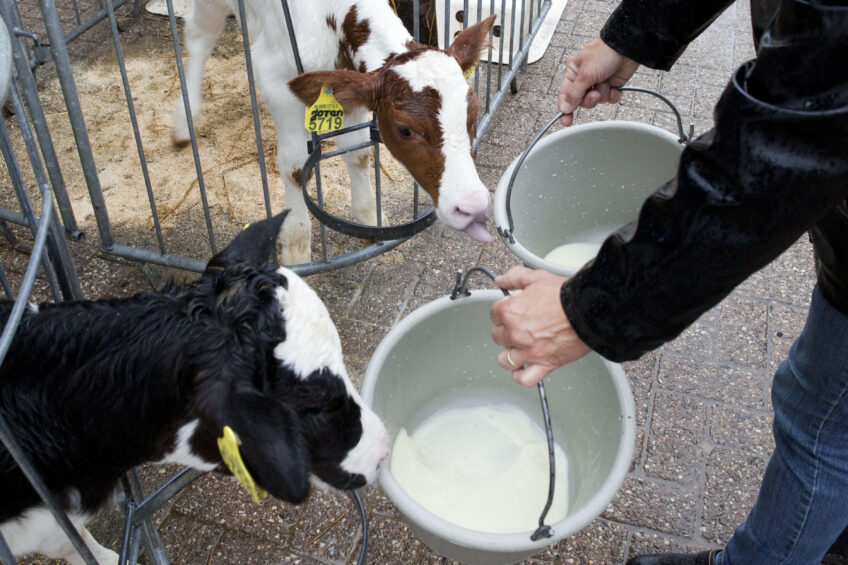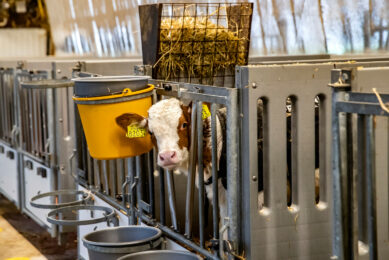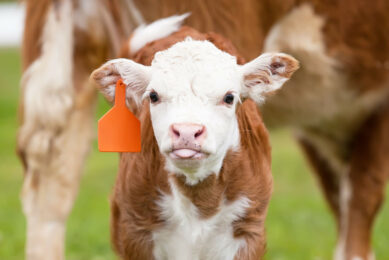Strong heifers through optimised nutrition

The first 2 months in the life of a dairy cow are critical. Nutritional programming can help to produce stronger heifers and hence have a better producing dairy cow.
The demand for dairy products will further grow with an estimated 53% towards the year 2050. This corresponds to a global rise in consumption per capita 83kg to 99kg of dairy products per person per year. The increased demand can be fulfilled by bigger farms, increased milk output per animal and further professionalisation of the dairy sector worldwide.
Challenges associated with bigger farms
The trend to have bigger farms may be efficient, but also comes with many new challenges. For example, calf and heifer management need more attention and some health issues might require more consideration (such as lameness).
Dairy heifer development plays an important role when aiming for better efficiency on dairy farms around the world. The practice of feeding calves, the post-weaning period up to first insemination and hence first lactation is far from being uniform.
Every farmer has their own approach
Every farmer has his or her on way and view of how best to raise youngstock to become high producing cows later in life. At the same time, their aims are often similar:
- less calf mortality
- reducing the period to first pregnancy and first calf born
The longer it takes before the young animal becomes a producing animal (and makes money) needs to be as short as possible.

Return of investment
Currently, the average cost for rearing youngstock, in the Netherlands for example, is € 1,567 per calf. It is in the farmers’ best interest to ensure the investment is paid back later in the animal’s production life. Trouw Nutrition (part of Nutreco) has been conducting dedicated research in dairy cattle for many years and developed a concept for optimum dairy heifer management (LifeStart). Insights into this concept and the associated research done at their calf and beef research centre in the Netherlands (opened in 2016) were discussed at a recent symposium themed ‘Breaking down barriers: dairy heifer development beyond weaning growth’, which took place in October in the Netherlands.
Metabolic programming
One of the driving forces behind the concept from Trouw Nutrition is the way calves can be metabolically programmed. “On a global level, productivity of dairy cows is on average 30-40% below their genetic potential. This is the result of suboptimal conditions and health,” explained Leo den Hartog, director Trouw Nutrition R&D. However, emerging technologies are available or becoming able to unlock the full genetic potential of dairy cows.
“Think of gene expression tools, the omics science, new feed evaluation tools, rapid diagnostics, precision livestock farming and the use of big data,” Mr den Hartog explained.
Epigenetics for example is a science that refers to changes in gene expression that are not related to the actual gene code of the animal. Nutrigenomics in turn refers to the effect of nutrition on these epigenetic processes, or the expression pattern of genes. Leonel Leal, researcher at Trouw Nutrition R&D and Wageningen University in the Netherlands, further explained this topic. He clarified that programmed nutrition can lead to earlier onset of puberty, better survival rates for calves, reduced age at first calving and ultimately increased milk production.

Study showing early and mid-term benefits
A longitudinal study, currently in progress by Mr Leal, has shown the early and mid-term benefits of the Trouw Nutrition concept and methodology. So far, it has been discovered that early dietary interventions can lead to profound metabolic adaptations especially with energy metabolism and organ development. Feeding 1.2kg/d of milk replacer to calves resulted in significantly different metabolic profiles one week before weaning (49 days of age) compared to calves receiving a more conventional provision of 0.6kg/d. “We have clear evidence that this approach pre-weaning induces significant changes in metabolite profiles, involving various metabolic pathways, through to 11 months of age,” Mr Leal explained. Feeding twice the amount of milk replacer also showed to influence the age that cows get pregnant for the first time. In the conventional group, it took 23 days longer to get the animals pregnant, compared to the trial group. The longitudinal study started in the first quarter of 2014 and Mr Leal expects results about the performance of the second lactation of these nutritionally programmed calves around 2019.
From milk replacer quantity to quality
The trials with feeding twice the amount of milk replacer showed excellent results, as discussed by Leonel Leal. But obviously also the quality of the milk replacer is important to make sure the digestive tract is developed in a healthy way and immunity levels are boosted. Dr Harma Berends, researcher at Trouw Nutrition R&D explained that it is important to educate farmers that it is worthwhile to move away from the traditional low quantities of (relatively) low quality milk to feeding the calves a higher plane of nutrition, based on high quality milk replacer. “We should aim for a growth of over 800 grams per day. This corresponds to approximately 20% of the calf’s bodyweight. The traditional way of feeding corresponds to 10% of the animals’ bodyweight (growth of 500-600 grams per day).
“But it is not only a matter of doubling the amount of milk fed every day. The formulation aspects are also very important. Examples of aspects to consider in a milk replacer are the protein quality, the amino acid: energy balance, trace elements, bioactives, the processing technology, energy source and the fatty acid composition,” Dr Berends explained. Dr Berends explained that trials are looking into several components of the milk replacer and the effect of development and health of the animals. “All these insights and studies help us in optimising our formulation of milk replacers, which can also be tailor-made for specific farm conditions or goals of the farmers for example,” Dr Berends said. Trouw Nutrition uses their own manufactured milk replacer (from its subsidiary Sloten BV), which is developed by using the spray dry technology, which leads to a milk replacer formulation with encapsulated fat and whey protein, which in turn leads to an optimal absorption of fat and protein in the digestive tract.

More research in the lower gut system
The importance of optimising gut function in calves and young dairy cows was further explained by Michael Steele, assistant Professor at the University of Alberta in Canada. “In general we see that 10% of calf mortality and 50% of morbidity is caused by calf diarrhoea. So there is much to win here,” explained Mr Steele. He empathised that most research studies in cattle are focusing on the rumen. “But luckily we see a shift now in more studies that delve into the lower gut system. Further along the digestive tract we see that the number of cell types increase and also the microbial richness and diversity increases. For calves specifically, it is important to look at this lower gut system.”
Mr Steele explained a study in which calves received colostrum, followed by a milk diet, or a combined colostrum: milk mix or a continued supply with only colostrum. Mr Steele: “We saw interesting results from this trial. In group 2 (colostrum, followed by 50% milk and 50% colostrum) we saw that the calves intestines had a higher villi length than the first group where calves received colostrum, followed by 100% milk. Higher villi length is preferable as it stands for more absorption capacity of the intestinal tract. We are now going to look, in more detail, in to the specific changes on gut level (on molecular level).” Alex Bach, research professor at ICREA and IRTA in Spain delved a little bit deeper in the economics. “The metabolic status of mammals in general during the first weeks of life seem to have long lasting effects. In dairy cattle we have learned that the faster the calves grow in the first two weeks of life, the more milk they will produce.” By supplying more milk, it is obvious that the calves also grow more. “But we need to find the balance in this and consider the whole growing phase. Trials that we did, showed that feeding 6 litres per day results in the desired growth of 800 grams and also have the lowest costs for the whole rearing period. The costs are higher when farmers decide to feed only 4 litres per day, as this corresponds to only 500 grams of growth per day. He also recommends feeding chopped forages / grass (2cm) to calves in the pre-weaning period, as this stimulates rumen passage and hence feed intake.
Conclusion
The first 2 months in the life of dairy calves is a critical period. The nutrition the calves receive during this period has been proven to have long-term effects on that animal’s performance capabilities throughout its life. Optimising nutrition through the use of nutritional programming for calves will help in reducing the untapped genetic potential and hence will boost milk production and overall efficiency of the farm. With the need for more dairy products in the future, the need to optimise calf and dairy heifer management will be even greater in the near future than it already is today.
Join 13,000+ subscribers
Subscribe to our newsletter to stay updated about all the need-to-know content in the dairy sector, two times a week.










